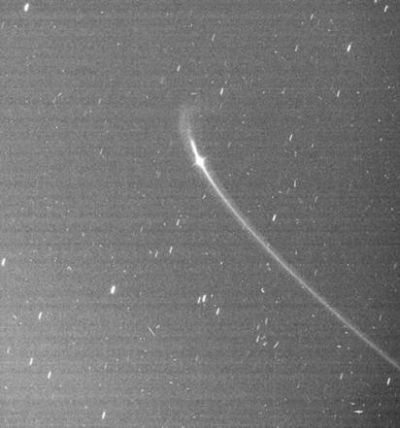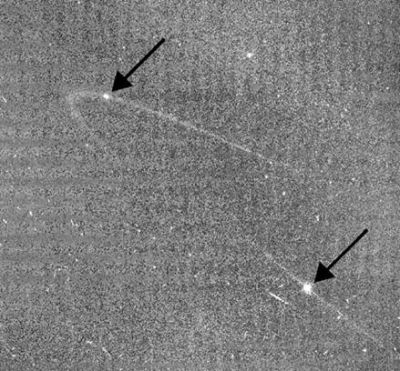10 September 2008

Images of Saturn-orbiting Cassini spacecraft reveal the existence of a faint arc of material orbiting with Saturn's small moon Anthe.
Image credit: NASA/JPL/Space Science Institute
NASA's Cassini spacecraft has detected a faint arc of material around Saturn. The arc is associated with a small Saturnian moon, known as Anthe. Cassini has further confirmed the existence of another arc orbiting Saturn with another moon, Methone. This is new evidence that most of Saturn's small, inner moons orbit within partial or complete rings.
Recent Cassini images show material, termed ring arcs, extending ahead of, and behind the tiny moons Anthe (approximately 2 km across) and Methone (approximately 4 km across) in their orbits. The new findings indicate that the gravitational influence of nearby moons on ring particles might be the determining factor in the formation of arcs and rings.
Both Anthe and Methone orbit Saturn in locations, known as resonances, where the gravity of the nearby larger moon Mimas (about 400 km across) perturbs their orbits. Gravitational resonances are also responsible for many of the structures in Saturn's magnificent rings.

Arrows indicate the positions of the moons Anthe, at top left, and Methone, at bottom right. Impacts of tiny meteorites (micrometeoroids) on the moons are the likely source of the arc material.
Image credit: NASA/JPL/Space Science Institute
Mimas provides a regular gravitational tug on each of the two moons, which causes the moons to drift forward and backward within an arc-shaped region along their orbital trajectories, according to Nick Cooper, a Cassini imaging team associate.
"When we realized that the Anthe and Methone ring arcs were very similar in appearance to the region in which the moons swing back and forth in their orbits due to their resonance with Mimas, we knew we had a possible cause-and-effect relationship," said Cooper.
Orbital resonance occurs when two orbiting bodies exert a periodic mutual gravitational influence on each other, usually due to their orbital periods being related by a ratio of two small integers. A remarkable example of orbital resonance is the 2:3 resonance between Pluto and Neptune, which means that Pluto completes two orbits in the same period of time Neptune takes to complete three orbits.
Scientists believe the faint ring arcs from Anthe and Methone likely consist of material knocked off these small moons due to the impacts of tiny meteorites, known as micrometeorites. This material does not spread all the way around Saturn to form a complete ring, due to the gravitational resonance with Mimas. That gravitational effect confines the material to a narrow region along the orbits of the moons.
This is the first detection of an arc of material near Anthe. The arc associated with Methone was previously detected by Cassini's Magnetospheric Imaging Instrument, and the new images confirm this discovery. Previous Cassini images reveal faint rings connected with other small moons either located within, or near the outskirts of Saturn's main ring system, such as Pan, Janus, Epimetheus and Pallene. Cassini had also previously observed an arc in the G ring, a faint major ring of Saturn.
"This is probably the same mechanism responsible for producing the arc in the G ring," said Matthew Hedman, a Cassini imaging team associate. The Cassini imaging team previously found that like the new small moon arcs, the G-ring arc is maintained by a gravitational resonance with Mimas.
"Indeed, the Anthe arc may be similar to the debris we see in the G-ring arc, where the largest particles are clearly visible. One might even speculate that if Anthe were shattered, its debris might form a structure much like the G ring," said Hedman.
Further analysis indicates that, while the gravitational influence of Mimas keeps the Anthe, Methone and G-ring arcs in place, the material that orbits with the moons Pallene, Janus and Epimetheus is not subject to such powerful resonant forces and is free to spread out around Saturn, forming complete rings without arcs.
The intricate relationships between these ring arcs and the moons are just one of many such phenomena that exist in the Saturn system. "There are many examples in the
Saturn system of moons creating structures in the rings and disturbing the orbits of other moons,” said Cassini Imaging Team Member Prof. Carl Murray. “Understanding these interactions and learning about their origins can help us to make sense of what we are seeing in the Cassini images."
Further Reading
Cassini-Huygens Mission to Saturn
http://saturn.jpl.nasa.gov/home/index.cfm
JPL Press Release
http://www.jpl.nasa.gov/news/news.cfm?release=2008-172
Aymen Mohamed Ibrahem
Senior Astronomy Specialist